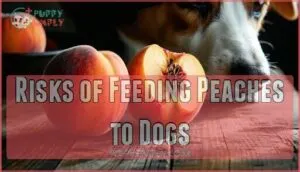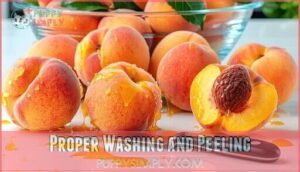This site is supported by our readers. We may earn a commission, at no cost to you, if you purchase through links.

Exploring dog-safe fruits means knowing which parts nourish and which threaten. If you’re wondering whether peaches belong in your dog’s bowl, the answer isn’t as simple as yes or no—let’s untangle the facts so you can treat your pup with confidence.
Table Of Contents
- Key Takeaways
- Can Dogs Eat Peaches Safely?
- Health Benefits of Peaches for Dogs
- Risks of Feeding Peaches to Dogs
- How to Prepare Peaches for Dogs
- Safe Peach Serving Guidelines
- Are Some Dogs Allergic to Peaches?
- What to Do if Your Dog Reacts Badly
- Can Puppies Eat Peaches?
- Healthy Fruit Alternatives for Dogs
- Frequently Asked Questions (FAQs)
- Are peaches good for dogs?
- What happens if a dog eats a Peach Pit?
- Can dogs eat peaches without a pit?
- Can dogs eat peach leaves?
- How many peaches can a dog eat?
- Can dogs eat canned peaches?
- How much peach should I give my dog?
- Are there any benefits to feeding my dog peaches?
- What are the signs of peach pit poisoning in dogs?
- Does peach flesh contain any allergens?
- Conclusion
Key Takeaways
- Peach flesh is safe for dogs in small portions, but pits, stems, and leaves are toxic and must always be removed.
- Feeding your dog too much peach can lead to digestive upset, weight gain, and possible allergic reactions.
- Always wash and peel peaches before serving to minimize chemical residue and reduce the risk of skin irritation.
- Stick to fresh, diced peaches as an occasional treat, making sure they’re less than 10% of your dog’s daily calories.
Can Dogs Eat Peaches Safely?
Regarding feeding peaches to your dog, safety isn’t always obvious. There’s more to this fruit than just sweet flesh and fuzzy skin. Let’s break down which parts are safe and which ones you should keep out of your dog’s bowl.
Which Peach Parts Are Dangerous?
When you share a peach with your dog, it’s worth knowing which parts are safe and which should stay far from their bowl. The flesh is fine, but peach pits carry cyanide content—a double risk for choking and poisoning. Peach leaves and stems contain toxic compounds, too. Even fuzzy skin can bother some pups. Sticking to the fruit’s soft center keeps things simplest.
Raw Vs. Canned Vs. Dried Peaches
Now that you know which peach parts to skip, let’s talk about how the way peaches are prepared can make a big difference for your dog’s health. Here’s how each type stacks up:
- Raw Peach Safety: Best peach type—fresh, washed, and peeled.
- Canned Sugar Content: Too much excess sugar, not safe food.
- Dried Nutrient Density: Dense, but easy to overfeed.
- Processing Method Impact: Skin, syrup, or additives can upset digestion.
Risks of Peach Pits, Leaves, and Stems
Before you slice up that peach for your dog, it’s important to know that the pit, leaves, and stems can turn a healthy snack into a real hazard. These plant parts contain toxic compounds—especially the peach pit, which can cause choking hazards, intestinal blockage, or cyanide poisoning.
Here’s a quick breakdown:
| Risk | What Happens |
|---|---|
| Choking hazards | Blocked airway |
| Cyanide poisoning | Toxic reaction |
| Intestinal blockage | Gastrointestinal obstruction in dogs |
Health Benefits of Peaches for Dogs
Peaches offer more than just a sweet flavor for your dog. There are some real nutritional perks worth knowing about.
Here’s what makes peaches a smart treat when served the right way.
Key Vitamins and Minerals
Did you know that a single peach packs a punch of vitamins and minerals that can help support your dog’s immune system, vision, and overall well-being? Vitamin A benefits include healthy eyes and skin, while vitamin C effects help fight inflammation.
Potassium, magnesium, and phosphorus aid heart and bone health, boosting mineral absorption and overall vitality in your dog’s daily diet.
Fiber and Antioxidant Content
Think of fiber benefits as the broom that sweeps your dog’s digestive tract clean, helping prevent constipation and keeping things running smoothly.
Antioxidant types—like flavonoids and vitamin C—work together for cellular protection. This vitamin synergy aids digestive health, boosts immune defenses, and adds real value to your dog’s nutrition, making peaches a smart seasonal treat.
Peach Nutrition Chart (per 100g)
Curiosity pays off when you know exactly what’s in a peach. Here’s a quick peach nutrition chart for your dog, per 100g:
- Macronutrient Breakdown: 39 kcal, 9.5g carbs, 1.5g fiber, 0.9g protein, 0.25g fat
- Vitamin Density: Vitamins A, C, E, niacin
- Mineral Composition: Potassium, magnesium, phosphorus
These support hydration, antioxidants, and digestive health. Peaches are also a medium nutrient-dense food source.
Risks of Feeding Peaches to Dogs
Before you share peaches with your dog, there are a few important risks to keep in mind. Some parts of the fruit can be dangerous, and even the sweet flesh has its drawbacks.
Here’s what you should watch out for.
Cyanide Poisoning and Choking Hazards
Peach pits pack a double punch: they’re a choking hazard and contain cyanide, which can poison your dog. If your dog swallows a pit, watch for cyanide symptoms—vomiting, drooling, or trouble breathing.
Choking prevention means removing pits every time. Toxicity levels vary, but emergency actions should be swift if you notice any signs of poisoning or obstruction.
High Sugar Content and Obesity
Sugar Overload isn’t just a buzzword—it’s a real concern for dogs. Peaches pack plenty of natural sugar, and even a few extra bites can tip the scales toward Weight Gain and Diabetes Risk.
Portion Control matters; treats should make up less than 10% of daily Caloric Intake. That’s how you keep Obesity at bay and support healthy diet choices.
Peaches are beneficial because they’re a good source of fiber.
Signs of Peach Toxicity
Watch for vomiting, drooling, trouble breathing, or sudden behavioral changes—these can point to cyanide symptoms or obstruction signs from peach pits. Digestive distress, allergic reactions, or fruit toxicity may also show up as diarrhea or skin irritation.
If you notice poisoning symptoms, don’t wait. Emergency care for dogs or a call to pet poison control is essential.
How to Prepare Peaches for Dogs
Getting peaches ready for your dog takes a bit of care and attention. You want to make sure every step keeps your pet safe. Here’s what to focus on before sharing this sweet treat.
Proper Washing and Peeling
Before you share a juicy slice with your dog, a good scrub and peel are your best defense against hidden dirt and chemicals. Washing methods matter—think of it as a fresh start. For dogs sensitive to peach skin or fuzz irritation, safe peeling helps. Here’s why it’s worth the effort:
- Residue Removal
- Chemical Concerns
- Fuzz Irritation
- Veterinary Advice
- Safe Serving Tips
Removing Pits, Stems, and Leaves
Use safe trimming tools to slice away every bit of stem and leaf—don’t underestimate their cyanide content or stem toxicity levels. If any residue concerns linger, double-check your work.
Pit removal methods matter, too, since even a single pit is a choking hazard and a source of pit danger.
Vet advice? Always discard these risky peach parts before serving.
Cutting Peaches Into Safe Portions
Now that you’ve cleared away pits, stems, and leaves, let’s talk about chopping that peach into pieces your dog can manage without a fuss. Follow these steps for peach safety:
- Dice flesh into ½-inch cubes—great for portion control and easy eating.
- Try peach puree for smaller pups or sensitive mouths.
- Freeze diced peaches for a cool summer treat.
Safe Peach Serving Guidelines
When sharing peaches with your dog, a few ground rules go a long way. Making smart choices helps keep snack time safe and healthy.
Here’s what to keep in mind before you offer that juicy bite.
Portion Size and Moderation
Finding the right amount of peach for your dog is a bit like adding just the right pinch of salt to a recipe—too much spoils the dish, but a little can make all the difference. Pay attention to Daily Limit, Calorie Counting, and Individual Needs.
Here’s a quick guide:
| Portion Guidelines | Serving Frequency | Weight Management |
|---|---|---|
| 1–2 bites | Weekly | Adjust as needed |
| Small cubes | Occasional | Monitor weight |
| Avoid excess | Not daily | Track calories |
Following The 10% Treat Rule
Just like you wouldn’t let dessert take over dinner, sticking to the 10% treat rule helps keep your dog’s peach portions in check. Calorie counting matters; treats for dogs, including fruit, should be no more than 10% of daily intake.
This treat percentage aids portion control and dog nutrition—helping you dodge obesity risks and follow dog treat guidelines.
Are Some Dogs Allergic to Peaches?
Just like people, some dogs can react to certain fruits, and peaches are no exception. It’s important to know what signs to watch for if your dog isn’t tolerating peaches well.
Here are a few things you’ll want to keep an eye out for.
Common Allergy Symptoms
Could your dog’s peach treat turn into trouble? Watch for skin irritation, digestive upset, or facial swelling—these allergy symptoms often signal an allergic reaction. Itchy paws and respiratory issues also pop up with pet allergies, especially food allergies.
For dog allergy considerations, any sudden change after eating peaches deserves a closer look. Prompt attention keeps your dog safe and comfortable.
Oral Reactions to Peach Fuzz
Although most dogs breeze past the fuzzy skin on a peach, some might end up with a tickle in their mouth or mild irritation that’s hard to ignore. Fuzz irritation can trigger oral discomfort or even allergic dermatitis, especially in breeds with sensitivity to pet allergies.
If you notice allergy symptoms after peach fuzz exposure, simple preventative measures—like peeling—can help.
Monitoring for Digestive Upset
After your dog enjoys a few bites of peach, it’s smart to keep an eye out for any tummy trouble over the next several hours. Watch for digestive issues like vomiting, diarrhea, stool changes, or appetite loss.
Subtle behavior changes and shifts in hydration levels can also hint at stomach upset. When in doubt, monitor for gastrointestinal issues and act quickly if vomiting signs appear.
What to Do if Your Dog Reacts Badly
If your dog starts acting strangely after eating peach, it’s important to know what warning signs to watch for. Some reactions can be serious and need quick action. Here’s what you should keep an eye out for next.
Signs of Choking or Obstruction
For instance, gagging, distressed behavior, or breathing difficulty are red flags. Blue gums signal a lack of oxygen—an emergency. If your dog can’t swallow, drools excessively, or seems panicked, obstruction or intestinal blockage could be the culprit.
Quick action is key; preventing dog choking hazards starts with knowing these signs and seeking emergency care right away.
Symptoms of Cyanide Poisoning
Imagine your dog suddenly acting confused, drooling more than usual, or struggling to breathe—these can be the first warning signs that cyanide poisoning is taking hold.
Watch for these symptoms of cyanide poisoning:
- Rapid onset timing—symptoms often appear within minutes.
- Brick-red gums, dilated pupils, or collapse.
- Severity factors: breed sensitivity, amount of peach pits, and specific toxins.
When to Consult a Veterinarian
You know your pup best, so if something feels off after they’ve had peaches, it’s always smarter to call your vet than hope for the best. Severe reactions, especially after possible cyanide ingestion or if you notice obstruction signs or allergic symptoms, mean you need veterinary advice ASAP.
Uncertainty over dosage concerns? Don’t hesitate—ask a vet for a quick consultation.
Can Puppies Eat Peaches?
Thinking about sharing a peach with your puppy? There are a few important things to think about before you let your young dog indulge.
Let’s take a look at what you need to know.
Age-Appropriate Treat Guidelines
Before offering peaches to your puppy, it’s wise to think about how age and development play a role in safe snacking. Young dogs have unique dietary needs, so keep these guidelines in mind:
- Start with tiny Puppy Peach Portions.
- Prioritize puppy nutrition and health.
- Choose safe treats over risky options.
- Introduce peaches slowly.
- Monitor for Senior Dog Concerns.
Risks for Smaller Breeds
A peach pit might seem harmless, but for puppies and small breeds, Pit Size and Breed Sensitivity matter. Even a single pit can cause a choking hazard or Intestinal Blockage, and the Cyanide Dosage from one pit is dangerous.
Watch out for obstruction if your dog coughs or gags after eating a peach. When in doubt, call your veterinarian.
Alternatives for Young Dogs
Given the risks that peach pits pose to puppies and smaller breeds, it’s smart to look for safer fruit options that still let your young dog enjoy a tasty treat.
Try these safe fruit alternatives for dogs:
- Soft bananas (small pieces)
- Pureed apples (no seeds)
- Blueberries (limited quantities)
- Vetapproved puppy foods
- Consult your vet for puppy health
Healthy Fruit Alternatives for Dogs
Peaches aren’t the only fruits you can share with your dog. In fact, there are several other options that offer their own health perks and safe snacking.
Here’s what you should know about dog-friendly fruits before you make your pick.
Dog-Safe Fruits List
Not every fruit bowl is a safe bet for your dog, but there’s a handful of tasty options that can add a splash of nutrition to their treat routine.
Here’s a quick guide to safe fruits for dogs—just remember to watch for seed concerns, fruit allergies, and stick to safe portions to support treat diversity and dog health and safety.
| Fruit | Safe Portions | Seed Concerns |
|---|---|---|
| Blueberries | 2-3 berries | None |
| Apples | 1-2 slices | Remove seeds |
| Bananas | 1-2 pieces | None |
| Watermelon | 1-2 cubes | Remove seeds |
Comparing Nutritional Benefits
Choosing the right fruit for your pup means balancing Vitamin comparison, Mineral benefits, and Fiber sources against the Caloric impact of each bite.
Peaches shine with Vitamin C and antioxidants, while apples offer crunch and bananas deliver potassium.
Dogs won’t care about labels, but the health benefits and nutritional benefits in every slice are what truly make the treat worth it.
Commercial Dog Treats With Peach
There’s something special about finding a treat that gives your dog the taste of summer and a boost of nutrition all in one bite. Reputable peach treat brands highlight ingredient sourcing and avoid artificial sweeteners, focusing on healthy treats with nutritional analysis and safe preservatives.
When choosing dog food and treats, check labels for real fruit and explore dog treat options crafted as healthy, flavorful alternatives.
Frequently Asked Questions (FAQs)
Are peaches good for dogs?
Isn’t it curious how something as sweet as a peach can be both a treat and a threat? Peach nutritional value shines with fiber benefits and vitamin content, but moderation is key for dog health and canine nutrition.
Peaches offer dogs both nutrition and risk, so moderation makes this sweet treat a safe and healthy choice
What happens if a dog eats a Peach Pit?
Swallowing a peach pit can trigger cyanide toxicity or cause intestinal blockage, especially in smaller breeds. The dangers of peach pits include choking hazards and obstruction, with pit digestion posing serious risks for cyanide poisoning in dogs.
Can dogs eat peaches without a pit?
As the saying goes, “better safe than sorry.” Peaches without a pit are generally safe for dogs, offering peach flesh benefits.
Pit removal importance is high due to cyanide risk details and choking dangers. Peach safety for dogs depends on proper prep.
Can dogs eat peach leaves?
Peach leaves contain toxic substances that can trigger cyanide toxicity in dogs. Leaf ingestion may lead to poisoning symptoms like vomiting or difficulty breathing.
Veterinary advice warns against peach toxicity in dogs—choose safe alternatives and avoid toxic foods.
How many peaches can a dog eat?
No dog should gobble a whole basket—stick to a few small cubes per day.
Daily peach limit depends on breed size, activity level, and individual dog factors.
Follow portion guidelines: treats ≤10% of daily caloric intake.
Can dogs eat canned peaches?
Canned peaches aren’t a safe choice for dog diet and health. Syrup concerns and added sugars can cause digestion issues, outweighing any nutritional value.
For pet health, stick to safe alternatives like fresh peach flesh or other safe foods.
How much peach should I give my dog?
A few small cubes—about one to two teaspoons—is a safe daily peach limit for most dogs.
Breed size matters, so adjust portion sizes based on activity level and individual dog factors, following dog nutrition guidelines for treats.
Are there any benefits to feeding my dog peaches?
Oddly enough, a sweet treat can also be a smart one. Peaches offer Vitamin Intake, Fiber Benefits, and an Antioxidant Boost, acting as a Hydration Source and Low-Calorie Snack for dog health and wellness, supporting their nutrition and diet.
What are the signs of peach pit poisoning in dogs?
Look for vomiting, difficulty breathing, dilated pupils, brick red gums, and staggering. Cyanide symptoms often appear within minutes to hours, so immediate actions matter.
Poisoning severity depends on pit size; emergency care for dogs is essential.
Does peach flesh contain any allergens?
Much like a hidden thorn in a rose, peach flesh can trigger mild allergic reactions in some dogs—think flesh allergy symptoms or oral irritation.
Breed sensitivities and cross-reactivity fruits mean allergy testing helps manage dog food allergies.
Conclusion
Picture your dog’s expectant eyes waiting for a treat—next time, you’ll know exactly how to keep that moment safe. Can dogs eat peach? Yes, but only when you’re mindful of pits, portions, and preparation.
Choosing fruit wisely isn’t just about nutrition; it’s about trust between you and your dog. With each careful slice, you’re building a routine that keeps risks low and tails wagging. Safety, after all, is the sweetest reward you can offer.
- https://rawfeeding101.com/blogs/dog-nutrition/can-dogs-eat-peaches/
- https://www.reddit.com/r/dogs/comments/aw5nfx/discussion_how_much_fruitsvegetables_canshould_i/
- https://www.aspca.org/pet-care/aspca-poison-control/toxic-and-non-toxic-plants/peach
- https://www.dialavet.com/blog/can-dogs-eat-peach-pits
- https://threehappyhounds.com/blog/sweet-treats-for-healthy-hounds-the-power-of-peaches-in-your-dogs-diet
















